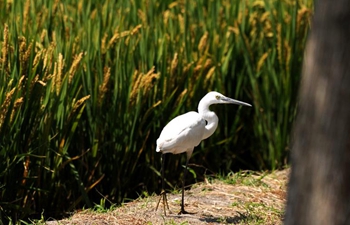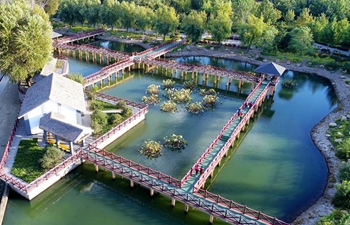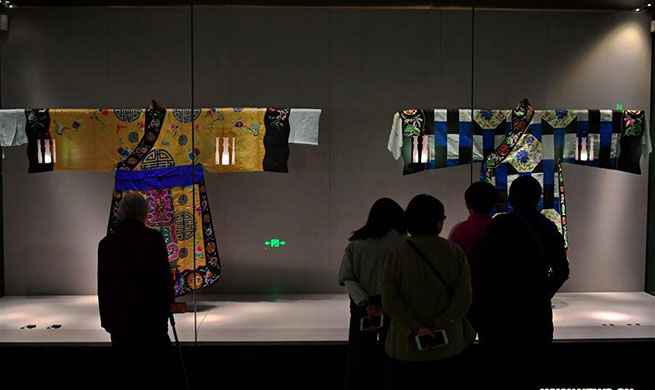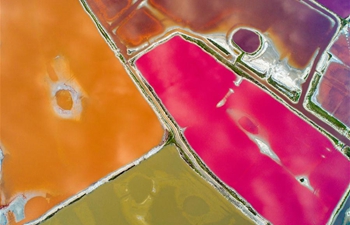ANKARA, Oct. 7 (Xinhua) -- Looted and missing pieces of the famous "Gipsy Girl" mosaic, found in the ancient Roman city of Zeugma which became the symbol of southeastern Turkey's Gaziantep, will be returned to Turkey at the end of October from the United States after years of diplomatic efforts.
Fatma Sahin, the mayor of Gaziantep, said that 12 ancient Zeugma mosaics looted during illegal excavations nearly 50 years ago and parts of the frames of the renowned mosaic will finally return after years of negotiations and diplomatic efforts.
"This is a four-year long work. We have worked with four of our ministers and our president intervened in this process. We have undertaken a serious work in diplomacy," said Sahin, calling the fascinating mosaic the "Turkish Mona Lisa."
Sahin explained that she will personally go to Ohio in the United States to pick up the artifacts. "The Gypsy Girl will be joining her family" in Zeugma, she added.
The "Gipsy Girl" named after its resemblance to gypsies is in fact believed to be GAIA, the ancestral mother of all life, according to Greek mythology.
It is among the most famous pieces of work on display at the Zeugma Mosaic Museum, the world's biggest one, which has attracted visitors from around the world since it opened in 2011.
The Gypsy Girl's disheveled hair, prominent cheekbones and haunting eyes have become somewhat of the face of Gaziantep since it was unearthed in the ancient city.
The missing and soon-to-be-returned pieces are currently on display in the United States at the Wolfe Arts Center of Ohio Bowling Green State University (BGSU).
An agreement has been sealed in May with this university for the repatriation of the artifacts.
According to the agreement, the cost of packing and transfer will be paid by the country's ministry. The BGSU will receive high-quality replicas of the mosaics from the Metropolitan Municipality of Gaziantep.
The Ohio university purchased the pieces from an antiquities dealer in 1965. They have been exhibited behind thick protective glass on the floor of the university's Wolfe Center for the Arts.
The pieces were said to be part of approved archaeological excavation overseen by Princeton University in Turkey's ancient city of Antioch, modern-day Antakya, until 2012.
Then researchers revealed that the pieces of chiseled stone and glass depicting masks of ancient Greek figures and birds actually formed part of a frame of a mosaic panel known as "Gypsy Girl."
Soner Atesogullari, head of Turkish Archeologists Association, hailed years of efforts deployed by the Turkish authorities to obtain the repatriation of the artifacts.
"We appreciate and support the diplomatic and judicial hunt launched by Turkey for the restitution of artifacts smuggled abroad," said the archeologist to Xinhua.
However, Atesogullari emphasized that education plays a crucial role in raising awareness on the cultural heritage of Turkey and that combating and punishing illegal excavations and treasure hunting, which is popular in Turkey and nowadays with metal detectors bought on the internet, is an absolute must.
The ancient city of Zeugma was founded in present day Gaziantep by one of Alexander the Great's generals in 300 B.C. and was conquered by the Roman Empire in 64 A.D.. It is known for its wealth of ancient Greek mosaics, frescoes, and artifacts.
The city became one of the major cities of the Roman eastern frontier with a garrison of over 6,000 soldiers. The city's bridge over the Euphrates river made it one of the most critical and wealthy trading centers in the region, on the silk routes to the East.
According to official data, the Turkish Ministry of Culture and Tourism has managed to obtain, after lengthy judicial and diplomatic procedures, some 4,300 artifacts illegally smuggled from Turkey, tracking dozens of pieces in around 20 countries by a team of experts.
Most recently, Turkey retrieved the stolen 2,200-year-old Sarcophagus of mythical Greek warrior Hercules from Switzerland.
This pearl of Turkey's historical richness is exhibited now at the Antalya Museum, the region where it was stolen from.
















